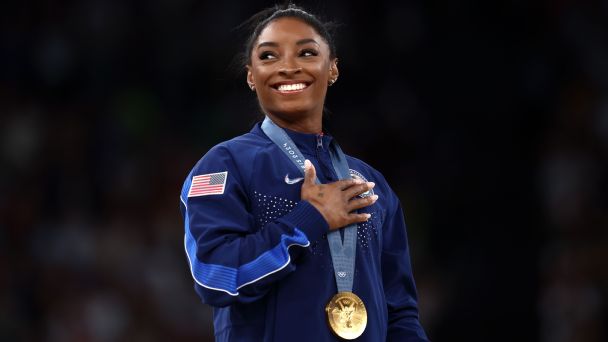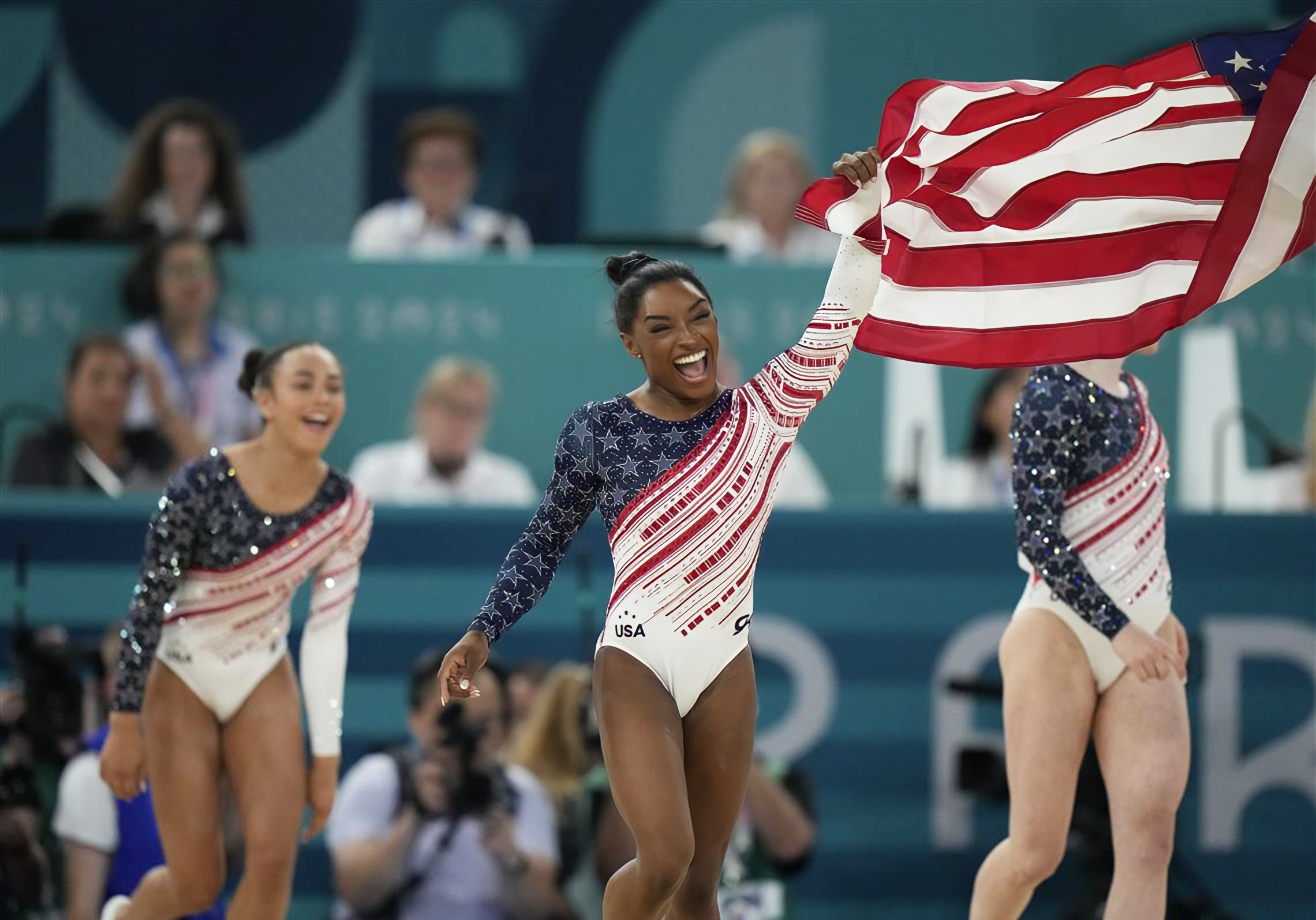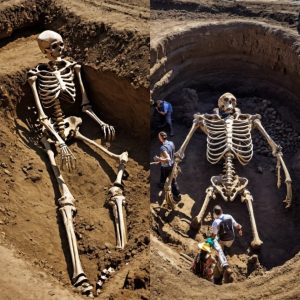PARIS — The silence speaks volumes.
Gymnastics meets at these Olympics have been loud, rowdy affairs. But there are these moments, just before Simone Biles mounts a balance beam or takes off down a vault runway or hits her opening pose on floor, when Bercy Arena falls utterly silent. Fans put their phones down and lift their eyes up and take in her performances the same way they might experience a work of art in the Louvre: with awe and respect and often without comprehension.
On Monday, Biles fell on beam and didn’t medal, and then she reset and performed what was perhaps the final floor routine of her illustrious career, closing out her third Olympics with an electrifying performance. While it wasn’t perfect, with two out-of-bounds penalties, Biles blasted her trademark triple-double into the rafters and stuck the landing as well as she ever has.

It is fitting that the last, and lasting, image of a remarkable week and a half of competition for the 27-year-old Texan will be Biles in the final pose of her iconic floor routine, its choreography an ode to her past, her evolution and her dominance. When she rose, the arena erupted in cheers of “USA!” as she walked off the floor, her arms held high overhead.
“I’ve accomplished way more than my wildest dreams, not just at this Olympics, but in the sport,” Biles said Monday. “A couple years ago, I didn’t think I’d be back here, so competing and walking away with four medals, I’m not mad at it. I’m pretty proud of myself.”
Biles leaves Paris with 11 Olympic medals, four of them earned at these Games. For some, she needed these medals, because they are the means by which they will weigh her legacy. Others will base their measure of her greatness on immeasurables such as the impact she will leave on her sport, inside the competition arena and beyond. Everyone has their own calculation for quantifying the greatest of all time.
But after these Olympics, this year, this shortened quadrennium, there is no debate. No matter the metric, Biles is the greatest gymnast of all time.
Biles is the most decorated American gymnast in history, and has won every all-around competition she has competed in since U.S. nationals in 2013. Aytac Unal/Anadolu via Getty Images

EVEN BEFORE THE delayed Tokyo Olympics, many considered Biles to be the best gymnast in history. But statistically, she still had challengers. She had yet to surpass two-time Olympian Shannon Miller’s medal count and, much like tennis great Serena Williams, found herself butting up against the legacies of gymnasts from an era that in many ways is incomparable to today.
By winning an eighth Olympic medal here in Paris, Biles became the most decorated American gymnast of all time. That she earned No. 8 in the team competition was especially gratifying for Biles and her teammates. Then she won a ninth, then a 10th and 11th, seven of them gold. No modern gymnast comes close. Only Larisa Latynina of the Soviet Union, who competed in three Games from 1956 to 1964, has more Olympic medals (18). Biles’ 11th medal ties her with Czech gymnast Vera Caslavska, who retired in 1968.
Biles has also earned more national titles and more world championship medals than any man or woman in history, and has a combined total of 41 world and Olympic medals.

“Honestly, I would have had to Google that,” Biles said when presented with those staggering statistics after the team final, when she and the self-proclaimed “Golden Girls” — because they won gold and are the oldest U.S. Olympic gymnastics team in history — earned the redemption they’ve been talking about so much.
“I don’t keep count. I don’t keep stats. I just go out here and do what I’m supposed to,” Biles said. “I’m doing what I love and enjoying it, so that’s all that matters to me.”
Biles did not need to return to the Olympics to prove anything to anyone but herself. But in doing so, she cemented the statistical measure of her legacy.
Simone Biles has five skills named after her, and some, like the Yurchenko double pike vault, may never be attempted again in women’s gymnastics at the Olympics. AP Photo/Francisco Seco
IF IMPACT ON her sport is the measure, consider this: Biles has five skills named after her, two on floor and vault and one on beam. No one has been more innovative in the sport’s current era, which has been defined by power and difficulty — and by Biles. Many of the skills may never be replicated. So far, only one gymnast has competed one of her skills, a double layout with a half twist called the Biles I on floor, at the Olympics.
“Simone definitely pushes me a lot,” three-time U.S. Olympic medalist Jade Carey said after the Paris vault final, where she earned bronze behind Biles and Brazil’s Rebeca Andrade. “She’s a really big inspiration to me, and seeing her pave the way for the sport is incredible. I’m just lucky to be competing alongside her.”

While pushing her competitors to be better, Biles has consistently asked the same of herself. She has won every all-around meet she has competed in for more than a decade, and for much of that time, her greatest competitor was herself. The difficulty of her routines is so high she often wins by margins that allow for her to count a fall — but sets the standard for execution scores, too. When she’s asked why she continues to push boundaries and innovate new skills, some of which, like the Yurchenko double pike vault, are terrifying and consequential, her answer encapsulates both her why and her how: “Because I can.”
In Paris, Biles didn’t run away with the all-around title. Even with her eponymous vault, which boasts the highest difficulty score in the sport, she was third after two rotations and a mistake on uneven bars. How she closed out the competition showcased just how fierce a competitor she is and how much she has grown since Tokyo.
After bars, Biles sat off on her own, legs crossed, eyes closed, “recentering and refocusing to finish,” she explained after the meet. Then she nailed the highest-scoring beam and floor routines of the night and won her second Olympic all-around title by more than a point over Andrade. “I’ve never had an athlete that close, so it definitely put me on my toes and brought out the best athlete in myself,” Biles said. “I was uncomfortable.”
U.S. teammates and coaches cheer as Biles finishes her floor routine, cementing the team gold medal on Tuesday. Getty Images
If, to be considered the greatest, an athlete’s influence must extend beyond the boundaries of her sport, Biles has, from the beginning, demonstrated a different way to win. When she arrived on the national team, the sport was defined at its elite level by silence and conformity. She and her coaches and family prioritized her mental and physical health above all, skipping national team camps when necessary and allowing Biles to have fun and share her life outside of the gym. By being unwilling to be molded to fit someone else’s ideal, she gave permission to other gymnasts to do the same.
“They used to try to put us in a box,” Biles said Thursday. “Whenever I came around, it wasn’t really my style. … Nobody could really talk and laugh, but I was like, that’s not how I do gymnastics. I’m going to continue to do it how I know and how I love because this is the reason I fell in love with the sport. We don’t have to be put in a box anymore.”
Biles won five Olympic medals in Rio in 2016, and led the team to gold. After, she became an advocate for change within the sport. Photo by David Ramos/Getty Images
BILES WON HER first Olympic all-around title at the Rio Games, and then became an outspoken critic of USA Gymnastics and the U.S. Olympic and Paralympic Committee, calling out their failures in the wake of revelations that longtime USAG doctor Larry Nassar had sexually abused hundreds of athletes, Biles included. She used her platform to provoke change within USAG, like the closing of the Houston training center owned by longtime U.S. coaches Bela and Martha Karolyi, and in the overall culture of the sport.
By being the most visible gymnast in the world for more than a decade, she has demonstrated longevity and influenced countless young athletes. At the 2022 U.S. championships in Tampa, Florida, the all-around podium featured three Black women for the first time in history. A year later, Biles topped the first all-around podium featuring three Black gymnasts at the world championships in Belgium.
“She’s changed the culture,” says three-time U.S. Olympic medalist Jordan Chiles. “Her skills, how she laughs and has fun and is so supportive and showed us to speak up and care about mental health. And she has a very creative mind. She’s so creative in the gym.”
Biles’ impact cannot be measured simply by the weight of her medals. “I don’t think I’ll truly understand the depth of it until I walk away from the sport,” Biles said last week.
At the Tokyo Olympics, Biles withdrew from the team finals and then all but beam finals after experiencing what gymnasts call the twisties. AP Photo/Ashley Landis
BILES BELIEVED HER career had ended three years ago at the Tokyo Games, when she experienced a dangerous loss of air awareness gymnasts refer to as the twisties and withdrew from all but one event final. It was disorienting for Biles in more ways than one.
“Leading up to Tokyo, I was so nervous about getting injured physically that I neglected my mental health,” Biles said Thursday, after becoming the first gymnast to win two Olympic all-around titles in nonconsecutive Games. “Then I was injured, except it was a mental injury. I think that was almost harder than physical. I never thought I’d be on a world stage again and competing.”
Biles knew that if she competed, she risked her personal safety, as well as her team’s medal chances. She was called selfish and a quitter by people who didn’t understand how selfless her decision was. Biles is a competitor. She worked for five years with a singular goal. It would have been easier to grit her teeth and stay in the game because, for years, that’s exactly what gymnasts did. It’s what they were coached and encouraged to do.
“I was 14 y/o w/ a tibial stress fracture, left alone w/ no cervical spine exam after this fall,” 1996 Olympic gold medalist Dominique Moceanu posted on Twitter shortly after Biles withdrew from competition, along with a video of her slipping during a beam performance at the 1996 Games and landing on her head. “Simone Biles’ decision demonstrates that we have a say in our own health — ‘a say’ I NEVER felt I had as an Olympian.”
It took time and years of therapy for Biles to understand the impact of her decision in Tokyo — on herself and on the rest of the world. So if having a societal impact is the measure, Biles brought mental health to the forefront when she stepped away to protect herself and her team from what could have happened next. By prioritizing her own health and safety, she started a conversation that continues to amplify. Here in Paris, she has spoken openly and often about her Thursday morning therapy sessions and the importance of mental health.
“Now athletes are a little more in tune and we trust what our gut is saying,” Biles said after the U.S. trials. “We’re taking mental health more serious.”
A young Biles fan in Paris during the first day of women’s competition. AP Photo/Abbie Parr
All week in Paris, young girls and boys wearing “Red, White and Biles” T-shirts have melted into puddles of tears and screams when Biles waves to them during competition. They’ve grown up knowing only a world in which Biles has been more icon than mere athlete. “We love you, Simone!” they yelled out before her final floor routine of the Olympics. “We love you!”
Had she won all the gold medals in Tokyo, Biles has said she would have been “crazy enough” to return for a third Olympics anyway. And had her story gone that way, she likely would have become the statistically greatest gymnast even sooner.
But her brand of greatness takes time. It is rarely achieved without challenge. Biles’ story is not one of uncontested superiority, but one of resilience and vulnerability. And it is her willingness to share her struggle with the world, while chasing greatness, that has made her impact immeasurable.





